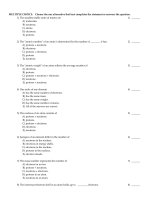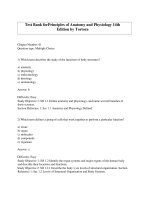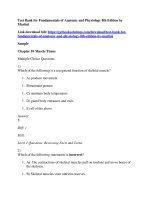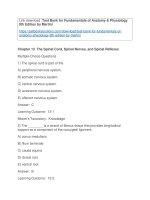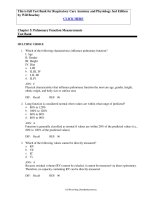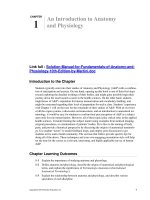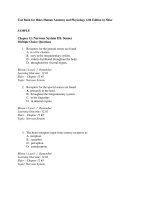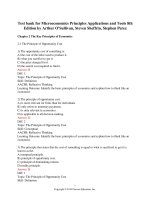Download test bank for fundamentals of anatomy and physiology 8th edition by martini download
Bạn đang xem bản rút gọn của tài liệu. Xem và tải ngay bản đầy đủ của tài liệu tại đây (721.24 KB, 184 trang )
Test Bank for Fundamentals of Anatomy and Physiology 8th Edition by
Martini
Sample
Chapter 10 Muscle Tissue
Multiple Choice Questions
1)
Which of the following is a recognized function of skeletal muscle?
A) produce movement
B)maintain posture
C) maintain body temperature
D) guard body entrances and exits
E) all of the above
2)
Which of the following statements is incorrect?
A) The contractions of skeletal muscles pull on tendons and move bones of the
skeleton.
1. B) Skeletal muscles store nutrient reserves.
C) Skeletal muscles are responsible for the pumping action of the heart.
D) Skeletal muscles support the weight of some internal organs.
E) Skeletal muscle contractions help maintain body temperature.
Answer: C
Diff: 1
Skill: Level 1 Questions: Reviewing Facts and Terms
3)
The dense layer of connective tissue that surrounds an entire skeletal muscle is the
1. A) tendon.
B) epimysium.
C) endomysium.
D) perimysium.
E) fascicle.
Answer:B
Level 1 Questions: Reviewing Facts and Terms
4)
Nerves and blood vessels that service the muscle fibers are located in
the connective tissues of the
A) endomysium.
B) perimysium.
C) sarcolemma.
D) sarcomere.
E) myofibrils.
Answer:B
Diff: 1
Skill:
Level 1 Questions: Reviewing Facts and Terms
5)
The delicate connective tissue that surrounds the skeletal muscle fibers and
ties adjacent muscle fibers together is the
A)
endomysium.
B)
perimysium.
C)
epimysium.
D)
superficial fascia.
E)
periosteum.
Answer:
A
Diff: 1
Skill:
Level 1 Questions: Reviewing Facts and Terms
6)
The bundle of collagen fibers at the end of a skeletal muscle that attaches the
muscle to bone is called a(n)
A)
fascicle.
B)
tendon.
C)
ligament.
D)
epimysium.
E)
myofibril.
Answer:
B
Diff: 1
Skill:
Level 1 Questions: Reviewing Facts and Terms
7)
Muscle fibers differ from “typical cells” in that muscle fibers
1. A)
lack a plasma membrane.
1. B)
have many nuclei.
1. C)
are very small.
1. D)
lack mitochondria.
E)
both B and C
Answer:
B
Diff: 1
Skill:
Level 1 Questions: Reviewing Facts and Terms
8)
The advantage of having many nuclei in a skeletal muscle fiber is
1. A)
the ability to contract.
1. B)
the ability to produce more ATP with little oxygen.
1. C)
the ability to store extra DNA for metabolism.
1. D)
the ability to produce large amounts of the muscle proteins needed for growth
and repair.
E)
both C and D
Answer:
D
Diff: 1
Skill:
Level 1 Questions: Reviewing Facts and Terms
9)
Skeletal muscle fibers are formed from embryonic cells called
A)
sarcomeres.
1. B)
myofibrils.
C)
myoblasts.
D)
fascicles.
E)
myomeres.
Answer:
C
Diff: 1
Skill:
Level 1 Questions: Reviewing Facts and Terms
10)
The plasma membrane of skeletal muscle is called the
A)
sarcolemma.
B)
sarcomere.
C)
sarcosome.
D)
sarcoplasmic reticulum.
E)
sarcoplasm.
Answer:
A
Diff: 1
Skill:
Level 1 Questions: Reviewing Facts and Terms
11)
Which of the following best describes the term sarcomere?
1. A)
protein that accounts for elasticity of resting muscle
1. B)
repeating unit of striated myofibrils
1. C)
storage site for calcium ions
1. D)
thin filaments are anchored here
1. E)
largely made of myosin molecules
Answer:
B
Diff: 1
Skill:
Level 1 Questions: Reviewing Facts and Terms
12)
Which of the following best describes the term sarcoplasmic reticulum?
1. A)
protein that accounts for elasticity of resting muscle
1. B)
repeating unit of striated myofibrils
1. C)
storage and release site for calcium ions
1. D)
thin filaments are anchored here
1. E)
largely made of myosin molecules
Answer:
C
Diff: 1
Skill:
Level 1 Questions: Reviewing Facts and Terms
13)
The repeating unit of a skeletal muscle fiber is the
A)
sarcolemma.
1. B)
sarcomere.
1. C)
sarcoplasmic reticulum.
D)
myofibril.
E)
myofilament.
Answer:
B
Diff: 1
Skill:
Level 1 Questions: Reviewing Facts and Terms
14)
Interactions between actin and myosin filaments of the sarcomere are responsible
for
A)
muscle fatigue.
B)
the conduction of neural stimulation to the muscle fiber.
C)
muscle contraction.
D)
muscle relaxation.
1. E)
the striped appearance of skeletal muscle.
Answer:
C
Diff: 1
Skill:
Level 1 Questions: Reviewing Facts and Terms
15)
In a sarcomere, thick filaments are linked laterally by proteins of the
A)
Z line.
B)
M line.
C)
H band.
D)
A band.
E)
I band.
Answer:
B
Diff: 1
Skill:
Level 1 Questions: Reviewing Facts and Terms
16)
Which of the following best describes the term Z line?
1. A)
protein that accounts for elasticity of resting muscle
1. B)
repeating unit of striated myofibrils
1. C)
storage site for calcium ions
1. D)
thin filaments are anchored here
1. E)
largely made of myosin molecules
Answer:
D
Diff: 1
Skill:
Level 1 Questions: Reviewing Facts and Terms
17)
The region of the sarcomere containing the thick filaments is the
A)
Z line.
B)
M line.
C)
H band.
D)
A band.
E)
I band.
Answer:
D
Diff: 1
Skill:
Level 1 Questions: Reviewing Facts and Terms
18)
The region of the sarcomere that always contains thin filaments is the
A)
Z line.
B)
M line.
C)
H band.
D)
A band.
E)
I band.
Answer:
E
Diff: 1
Skill:
Level 1 Questions: Reviewing Facts and Terms
19)
The area in the center of the A band that contains no thin filaments is the
A)
Z line.
B)
M line.
C)
H band.
D)
I band.
E)
zone of overlap.
Answer:
C
Diff: 1
Skill:
